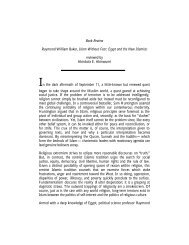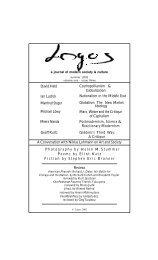Michael J. Thompson Stephen Eric Bronner Wadood Hamad - Logos
Michael J. Thompson Stephen Eric Bronner Wadood Hamad - Logos
Michael J. Thompson Stephen Eric Bronner Wadood Hamad - Logos
You also want an ePaper? Increase the reach of your titles
YUMPU automatically turns print PDFs into web optimized ePapers that Google loves.
Ali Hossaini<br />
becoming true in the fundamental sense, mainly because media now<br />
integrates our perceptual apparatus. The convergence of technology with<br />
biology continues on the level of image processing. Like human vision, the<br />
camera produces internal representations of the world which can be recalled<br />
and manipulated. Fidelity is key to photography and natural perception<br />
because both are directed toward depicting an environment that must be<br />
exploited for navigation, communication and survival. Thus the ontology of<br />
the photograph derives from its fundamental utility as a representation of the<br />
visual environment—and from the act of vision itself.<br />
Andre Bazin presented one of the first theoretic statements regarding<br />
photographic realism in his essay, “What is a Photograph,” which appeared<br />
in 1937. He attributes a simple realism to the medium, as he opens and shuts<br />
the door on a theory of photography.<br />
Besides, painting is . . . an ersatz of the processes of<br />
reproduction. Only a photographic lens can give us the kind<br />
of image of the object that is capable of satisfying the deep<br />
need man has to substitute for it [the object] something more<br />
than a mere approximation . . . The photographic image is<br />
the object itself, the object freed from the conditions of time<br />
and space that govern it. No matter how fuzzy, distorted, or<br />
discolored, no matter how lacking in documentary value the<br />
image may be, it shares, by virtue of the very process of its<br />
becoming, the being of the model of which it is the<br />
reproduction; it is the model. 5<br />
Even as he gives the final word on photography, Bazin indicates that cinema<br />
is a much richer field for theory, closing with, “On the other hand, cinema is<br />
also a language.” Bazin subsequently founded the field of cinema studies, and<br />
for decades scholars had little to say about photography. In the late 1950s,<br />
Roland Barthes discussed photographs, taking a linguistic approach adopted<br />
in the 1970s by a coterie that included Alan Sekula, Victor Burgin and Judith<br />
Williamson. Since then a field of critical photographic studies has emerged to<br />
analyze the various uses of photography in propaganda, advertising,<br />
surveillance and personal life.<br />
Though placed in a multitude of disciplines, most studies of photography are<br />
either sociological, seeking a language of photography within its human<br />
elements, or phenomenological, attending to the mysteries of perception at a<br />
<strong>Logos</strong> 2.3 – Summer 2003




